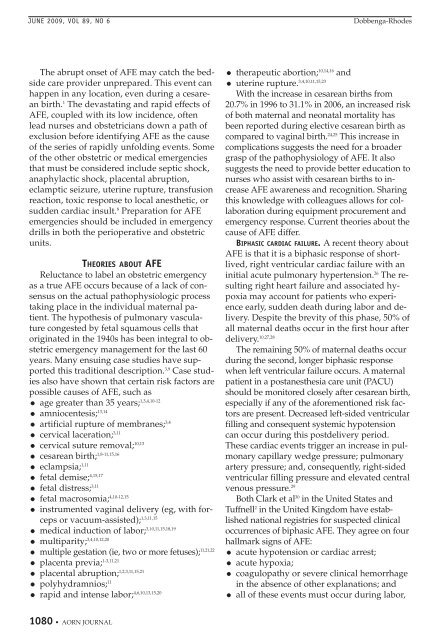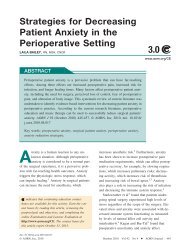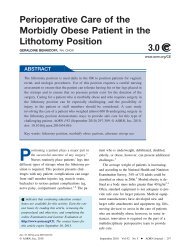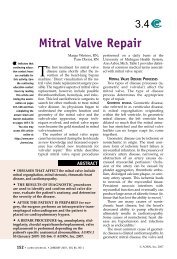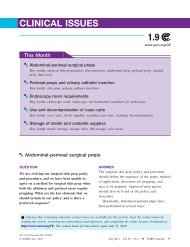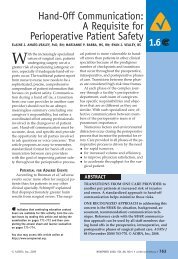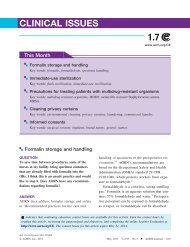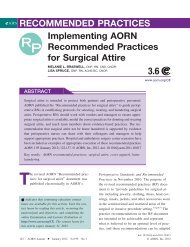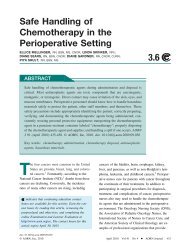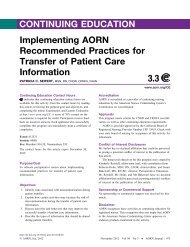Responding to Amniotic Fluid Embolism - AORN
Responding to Amniotic Fluid Embolism - AORN
Responding to Amniotic Fluid Embolism - AORN
Create successful ePaper yourself
Turn your PDF publications into a flip-book with our unique Google optimized e-Paper software.
JUNE 2009, VOL 89, NO 6Dobbenga-RhodesThe abrupt onset of AFE may catch the bedsidecare provider unprepared. This event canhappen in any location, even during a cesareanbirth. 1 The devastating and rapid effects ofAFE, coupled with its low incidence, oftenlead nurses and obstetricians down a path ofexclusion before identifying AFE as the causeof the series of rapidly unfolding events. Someof the other obstetric or medical emergenciesthat must be considered include septic shock,anaphylactic shock, placental abruption,eclamptic seizure, uterine rupture, transfusionreaction, <strong>to</strong>xic response <strong>to</strong> local anesthetic, orsudden cardiac insult. 8 Preparation for AFEemergencies should be included in emergencydrills in both the perioperative and obstetricunits.THEORIES ABOUT AFEReluctance <strong>to</strong> label an obstetric emergencyas a true AFE occurs because of a lack of consensuson the actual pathophysiologic processtaking place in the individual maternal patient.The hypothesis of pulmonary vasculaturecongested by fetal squamous cells tha<strong>to</strong>riginated in the 1940s has been integral <strong>to</strong> obstetricemergency management for the last 60years. Many ensuing case studies have supportedthis traditional description. 3,9 Case studiesalso have shown that certain risk fac<strong>to</strong>rs arepossible causes of AFE, such as• age greater than 35 years; 1,3,4,10-12• amniocentesis; 13,14• artificial rupture of membranes; 3,4• cervical laceration; 3,11• cervical suture removal; 10,13• cesarean birth; 1,8-11,15,16• eclampsia; 1,11• fetal demise; 4,15,17• fetal distress; 3,11• fetal macrosomia; 4,10-12,15• instrumented vaginal delivery (eg, with forcepsor vacuum-assisted); 1,3,11,15• medical induction of labor; 3,10,11,15,18,19• multiparity; 3,4,10,12,20• multiple gestation (ie, two or more fetuses); 11,21,22• placenta previa; 1-3,11,21• placental abruption; 1,2,3,11,15,21• polyhydramnios; 11• rapid and intense labor; 4,6,10,13,15,20• therapeutic abortion; 10,14,16 and• uterine rupture. 3,4,10,11,15,23With the increase in cesarean births from20.7% in 1996 <strong>to</strong> 31.1% in 2006, an increased riskof both maternal and neonatal mortality hasbeen reported during elective cesarean birth ascompared <strong>to</strong> vaginal birth. 24,25 This increase incomplications suggests the need for a broadergrasp of the pathophysiology of AFE. It alsosuggests the need <strong>to</strong> provide better education <strong>to</strong>nurses who assist with cesarean births <strong>to</strong> increaseAFE awareness and recognition. Sharingthis knowledge with colleagues allows for collaborationduring equipment procurement andemergency response. Current theories about thecause of AFE differ.BIPHASIC CARDIAC FAILURE. A recent theory aboutAFE is that it is a biphasic response of shortlived,right ventricular cardiac failure with aninitial acute pulmonary hypertension. 26 The resultingright heart failure and associated hypoxiamay account for patients who experienceearly, sudden death during labor and delivery.Despite the brevity of this phase, 50% ofall maternal deaths occur in the first hour afterdelivery. 10,27,28The remaining 50% of maternal deaths occurduring the second, longer biphasic responsewhen left ventricular failure occurs. A maternalpatient in a postanesthesia care unit (PACU)should be moni<strong>to</strong>red closely after cesarean birth,especially if any of the aforementioned risk fac<strong>to</strong>rsare present. Decreased left-sided ventricularfilling and consequent systemic hypotensioncan occur during this postdelivery period.These cardiac events trigger an increase in pulmonarycapillary wedge pressure; pulmonaryartery pressure; and, consequently, right-sidedventricular filling pressure and elevated centralvenous pressure. 29Both Clark et al 30 in the United States andTuffnell 2 in the United Kingdom have establishednational registries for suspected clinicaloccurrences of biphasic AFE. They agree on fourhallmark signs of AFE:• acute hypotension or cardiac arrest;• acute hypoxia;• coagulopathy or severe clinical hemorrhagein the absence of other explanations; and• all of these events must occur during labor,1080 • <strong>AORN</strong> JOURNAL


